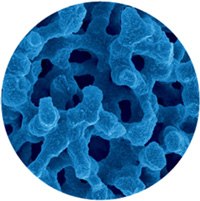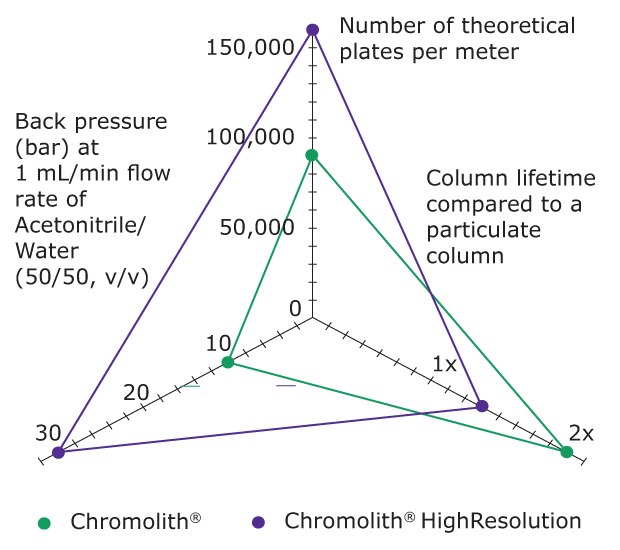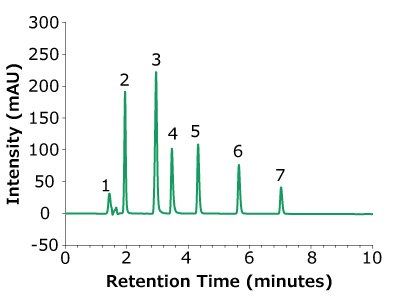Chromolith® HPLC & UHPLC columns
Section Overview
- Introduction
- Chromolith® RP-18 endcapped Columns
- Chromolith®RP-8 endcapped Columns
- Chromolith® CN, NH2, and Diol Columns
- Chromolith® Si Columns
- CapRod® Monolithic LC Capillary Columns
- Chromolith® HPLC Column Coupler
- Chromolith® Guard Cartridges and Kit
- Chromolith® SemiPrep HPLC Columns
- Handling Video: Chromolith® HPLC column with Pre-Column
- Ordering Information

Electron-Microscope photo of monolithic silica structure.
Introduction
Chromolith® HPLC columns are designed using sophisticated monolithic silica technology. These columns are made from a continuous piece of ultra-pure, fully porous silica (Type B) using a sol-gel process, resulting in a well-defined bimodal pore structure with both macropores and mesopores in the micro- and nanometer range. The silica skeleton's high permeability and porosity results in significantly lower column back pressure, allowing for more variable flow rates and the use of mobile phases with higher viscosity than typical particle columns. This feature allows for high-throughput analysis while retaining separation efficiency and peak capacity.
Download & Read the Chromolith® Monolithic Silica HPLC Columns Brochure.
The revolutionary, bimodal pore structure of Chromolith® columns provides unique benefits:
- Rapid separations at very low column back-pressure
- Standard HPLC instruments are fully compatible with all Chromolith® columns and UHPLC instruments are fully compatible with Chromolith® 2 mm I.D. columns.
- Matrix-rich samples (such as food, life science samples, or complex pharmaceutical formulations) can be analyzed without the need for sophisticated and time-consuming sample preparation. Guard column cartridges are also available to extend lifetime and applicability even further.
- Cost-savings are achieved as the column lifetimes are much longer than for particulate HPLC columns, in particular when analyzing matrix-rich samples.
- Complex multi-component samples can be separated either by using Chromolith® HighResolution (HR) columns or by using long very high-efficiency columns formed by connecting two or more Chromolith® columns together. The low-column backpressure makes this possible.
- 2 mm I.D. Columns are best suitable for LC-MS methods and provide higher sensitivities
- Easy transfer of methods from a particulate column to a Chromolith® column.
- The very low column backpressure allows the use of sustainable/greener mobile phases such as bioethanol.
- Chromolith® WP 300 columns have 300 A mesopores and therefore are an excellent solution for the separation of larger Biomolecules
Classic Particulate Columns Versus Chromolith® HPLC Columns
Using HPLC columns with silica particles often leads to excessive back pressure. This can harm both the column and the HPLC system, thus traditional HPLC columns have a limited length and potential plate count. Attempts have been made to raise the plate count by reducing particle size, however, this causes undesirable back pressure and restricts the number of separations that can be satisfactorily achieved.
Learn more about the UHPLC Analysis of Diclofenac in Gel using a Monolithic Silica Column, Analysis of Clobetasol propionate in whitening cream on Chromolith® HighResolution RP-18e 100 x 2 mm I.D. Column, and Cannabinoids Analysis in Cannabis Using a High Resolution Monolithic Silica HPLC Column.
Chromolith® HPLC columns are the best choice for further accelerating the process. Chromolith® columns, with their unique bimodal pore structure, deliver outstanding separations in a fraction of the time that a typical particulate column does. This allows for faster speeds and increased sample throughput while maintaining lower back pressure.
Chromolith® columns are available with several pore structures enabling the optimal performance for different demands and with multiple phase modifications:
Chromolith® RP-18 endcapped Monolithic Silica HPLC Columns
Chromolith® RP-18 endcapped columns are designed for fast, robust separation of hydrophobic to medium polar compounds at low back pressure. They are well-suited for matrix-rich samples and offer high throughput, lower matrix sensitivity, and extended column lifetime. Chemically modified with n-alkyl chains for high ligand density and fully endcapped to reduce silanol group activity, these columns are ideal for reversed-phase chromatography.
These columns are made from high-purity, metal-free silanes and undergo the same surface modification techniques as high-end particle-packed columns. As a result, their chromatographic selectivity is comparable to that of high-quality C18-encapped reversed-phase particle columns. This enables their easy incorporation into standard procedures for generating new protocols, as well as the conversion of existing particle column-based methods to these columns.
Chromolith® RP-18e columns are listed in the US Pharmacopoeia columns under the category L1.
Specifications of Chromolith® RP-18 endcapped Monolithic Silica HPLC Columns
Chromolith® RP-18 endcapped columns are available in column inner dimensions of 4.6 mm, 3 mm and 2 mm for analytical applications as well as in 10 mm, and 25 mm i.D. for Semi-preparative use. In addition, capillary columns are available.
Chromolith® HighResolution RP-18 endcapped HPLC Columns
Chromolith® HighResolution RP-18 endcapped columns combine the advantages of high flow rates, low matrix sensitivity, low back pressure, and extended column lifetime with even higher efficiency. These columns are designed for quick, robust, and efficient separation of hydrophobic to medium polar chemicals. They are a perfect alternative to sub-3 µm particulate columns and give equivalent results to core-shell particle columns at a significantly lower back pressure. Furthermore, Chromolith® HighResolution columns last more than 30% longer than particle columns.
These columns are made from high-purity silica with a bimodal structure and have smaller macropores (1.15 μm) than conventional Chromolith® columns. This results in at least 50% higher efficiency and improved peak symmetry. While the back pressure is larger than in normal Chromolith® columns, it is still less than half that of particle columns of comparable size. Because the chemical basis of Chromolith® HighResolution RP-18e columns is the same as that of high-end particulate silica columns (such as Purospher® columns), they can be easily used in standard methods when developing new protocols, and method transfer from particulate columns to monolithic Chromolith® RP-18 columns.
Features & Benefits
- High throughput at elevated flow rates
- Lower matrix sensitivity
- Comparable performance to sub-3 µm particle-packed columns
- At least 50% higher efficiency than standard Chromolith® columns
- Back pressure is less than half that of particulate columns
- Over 30% longer column lifetime
- Capability for flow gradients and column coupling
- Simple method transfer from particulate to monolithic columns
Comparison of Chromolith® and Chromolith® HighResolution columns

Chromolith® HR columns deliver similar results to 3 μm fully porous particles (FPP) or 2.7 μm superficially porous particles (SPP) columns, but at much lower back pressures.

Silica monolith: Chromolith® HighResolution RP-18e
Pressure = 36 bar

Fully porous silica particle (FPP) C18, 3μm
Pressure= 146 bar

Superficially porous silica particle (SPP) C18, 2.7 μm
Pressure = 170 bar
Specifications of Chromolith® HighResolution RP-18 endcapped Monolithic Silica HPLC Columns
Chromolith® RP-8 endcapped and Chromolith® HighResolution RP-8 endcapped Monolithic Silica HPLC Columns
Chromolith® RP-8 endcapped columns provide enhanced retention for hydrophobic compounds compared to the RP-18 columns. With shorter alkyl chains, they offer reduced retention and slightly different selectivity, enabling baseline separations that may not be achievable with RP-18 columns under identical elution conditions.
These columns retain the same benefits as Chromolith® RP-18 columns, including fast throughput, long column lifetime, low matrix sensitivity, and the possibility of pairing columns for maximum performance. Made from high-purity silica, they decrease the impact of trace metals and the n-alkyl chains with high ligand density are fully endcapped to reduce unmodified silanol activity.
Features & Benefits:
- Superior retention for hydrophobic compounds
- High throughput at elevated flow rates
- Flow gradient compatibility
- Enhanced performance through column coupling
- Rigid monolithic structure for extended lifetime
- Lower matrix sensitivity
Specifications of Chromolith® RP-8 endcapped and Chromolith® HighResolution RP-8 endcapped Monolithic Silica HPLC Columns
Chromolith® CN, NH2, and Diol Monolithic Silica HPLC Columns
Chromolith® columns with polar modifications (CN, NH2 and Diol) are suitable for the separation of polar compounds. These column chemistries can be used for Normal-phase conditions as well as with Reversed phase mobile phases (HILIC -mode).
Cyano columns are generally more polar than traditional alkyl silica columns. The functional groups are highly ordered, reducing steric hindrance for the solute. The modification also allows cation exchange activity, which is higher at neutral pH than in acidic conditions. Chromolith® CN columns are suitable for the separation of alkaloids, oils, flavonoids, glycols, phenols, phthalates, steroids, and sulfonamides.
Chromolith® aminopropyl-modified columns possess medium polarity, between those of bare (normal-phase) silica and reversed-phase silica. Consequently, these columns display hydrophilic as well as hydrophobic properties and can be used under both reversed-phase and normal-phase conditions. These columns are suitable for the separation of anions, organic acids, and carbohydrates (mono and disaccharides, such as fructose, glucose, sucrose, maltose, and lactose).
Chromolith® Diol columns are more versatile than bare silica columns and often offer improved reproducibility. The bonded phase’s hydroxyl groups provide good selectivity without excessive retention. This trait is due to weaker hydrogen bonding with diol groups than with silanols on a bare silica surface. In aqueous phases, the diol phase can effectively shield the silica surface from interacting with proteins. Diol columns are commonly used for the separation of steroids and sterols under normal-phase conditions. Chromolith® Diol columns are suitable for the separation of alcohols, amino acids, carotenoids, oils, glycols, preservatives, proteins, sugars, sulfonamides, and water-soluble vitamins.
Specifications of Chromolith® CN, NH2 and Diol Monolithic Silica HPLC Column
Chromolith® Si Monolithic Silica HPLC Columns
Chromolith® Si HPLC columns are specifically designed for normal-phase separations of polar, non-ionic organic molecules. They offer the entire benefits of monolithic silica technology, such as high throughput, prolonged column lifetime, reduced matrix sensitivity, and improved performance via column coupling. These columns are made of high-purity silica and efficiently reduce the influence of trace metals.
Specifications of Chromolith® Si HPLC columns
Chromolith® CapRod® Monolithic LC Capillary Columns
The Chromolith® CapRod® capillary HPLC columns combine monolithic silica technology with nano-LC sensitivity, increasing productivity for high-throughput and high-sensitivity proteomics LC applications. These columns are specifically intended for the efficient and selective separation of peptides and protein digests. The sol-gel method utilized to produce the columns is especially favorable for capillary and nano-LC applications, as it improves separation performance and sensitivity.
Unlike conventional columns, Chromolith® CapRod® capillaries are not limited by column length and can be bent to a certain degree in order to accommodate different LC layouts and instruments. These monolithic capillary columns are compatible with a variety of nano or capillary LC systems and offer improved efficiency and performance when connected to mass spectrometers, both on-line (ESI, nanospray) and off-line (MALDI). These columns can operate at higher flow rates without any degradation in performance or issues related to column back pressure. Flow rates can be significantly increased while maintaining resolution, allowing separations to be performed at 1-3 μL/min, in contrast to the 200-400 μL/min typically required for conventional media in a standard 100 μm LC capillary column.
CapRod® columns have a dual-pore structure with large macropores (~2 µm) and small mesopores (13 nm), resulting in a highly porous monolithic rod of pure silica. The macropores allow for quick eluent flow, considerably lowering separation times, but the mesopores provide a fine-pore structure within the capillary, offering a vast surface area for effective adsorption of target molecules.
Chromolith® CapRod® columns come in a variety of internal diameters (50 μm, 100 μm, and 200 μm), bonded phases (C8, C18), pore shapes (standard and high resolution), and lengths (5, 15, and 30 cm). Each column comes with sleeves and standard 1/16" PEEK fittings for connecting directly to a UV detector or mass spectrometer. Trapping capillaries are also available, designed to protect the separation column and enhance efficiency when working with complex biological samples.
Features & Benefits
- Superior performance with optimal resolution (narrow peak widths)
- Enhanced sample throughput for maximum productivity
- Greater efficiency due to prolonged column lifetime
- Higher flow rates thanks to unique bimodal pore structure
- Greater flexibility for best fit to any LC configuration and instrument
Chromolith® CapRod® Columns
Chromolith® HPLC Column Coupler
The Chromolith® HPLC column coupler enables the combination of several monolithic columns to improve separation efficiency by increasing the potential plate count beyond that of particle columns, while keeping pressure below the system limit. This enhances column performance, making it excellent for overcoming crucial separation difficulties and handling complicated mixes that were previously unsuitable for separation.
Table below shows a comparison between Chromolith® HPLC columns and particulate columns. The use of only two Chromolith® Performance RP-18 endcapped columns results in a separation efficiency of 19,000 theoretical plates per column, which is often the maximum for particle columns.
Chromolith® Guard Cartridges and Kit
Chromolith® guard cartridges and kits offer optimum protection of analytical columns against chemical or mechanical contamination, significantly extending column lifetime. The guard cartridges are chemically modified with hydrophobic n-octadecyl (C18) groups on a monolithic silica rod, making them suitable for reversed-phase chromatography.
Guard Cartridges
Chromolith® guard cartridges, available in 5 and 10 mm lengths, are easy-to-use and provide the benefits of monolithic technology. These guard columns are also excellent at protecting classical packed columns and should be changed on a regular basis to prevent impurities from building up.
Guard Cartridge Starter Kit
The Chromolith® guard cartridge package comprises a guard cartridge holder and three guard cartridges, providing a comprehensive solution for extending column life.
Chromolith® SemiPrep HPLC Columns
Chromolith® SemiPrep HPLC columns are ideal for scaling up from analytical to semi-preparative separations, providing faster throughput at lower pressure than 5 μm-packed semi-prep columns. They are highly effective at separating non-polar basic and acidic compounds, as well as peptides.
With a 10 mm internal diameter, they are an efficient alternative to particle columns with diameters of 10 mm and 21.2 mm, giving selectivity comparable to RP-18 endcapped reversed-phase columns. The rugged monolithic silica structure, identical to Chromolith® analytical columns (4.6 mm I.D.), ensures a long column lifetime. The 2 μm macropores reduce separation time, while the 13 nm mesopores offer a large surface area for adsorption.
Features & Benefits:
- Direct scale-up from analytical to semi-prep
- Faster throughput at lower operating pressure than 5 μm columns
- Sharp separations, even with high sample loads
- Extended lifetime due to robust monolithic structure
- LC/MS optimized with minimal column bleeding
- High performance at various flow rates
- Ideal alternative to 10 mm and 21.2 mm I.D. particulate columns
The Chromolith® HPLC and UHPLC monolithic silica columns are cladded in inert PEEK (polyetheretherketone) polymeric material and can be connected directly to HPLC, UHPLC or UPLC system as a “ready to use” column.

Chromolith column
Chromolith® Holder
如要继续阅读,请登录或创建帐户。
暂无帐户?